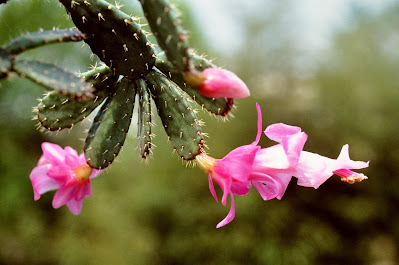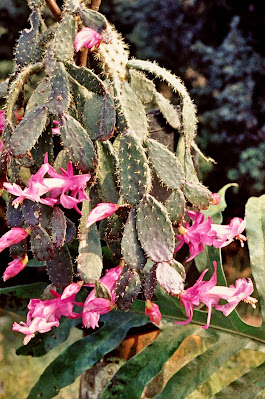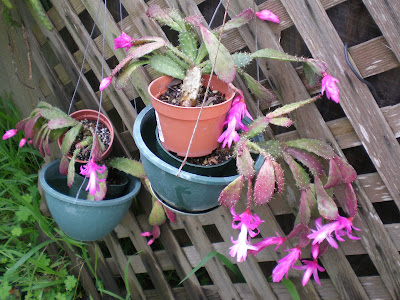Schlumbergera opuntioides blooms in the spring from the areoles that occur on the segments and have bristles which become stiffer with age...
Schlumbergera opuntioides also called as Epiphyllum obovatum, Epiphyllanthus obovatus, Epiphyllum opuntioides, Zygocactus opuntioides, Epiphyllanthus opuntioides, is a species of the genus Schlumbergera. This species was described by David Richard Hunt in 1969. The specific epithet opuntioides means "like Opuntia", referring to the appearance of the stems.
IDENTIFY SCHLUMBERGERA OPUNTIOIDES
Schlumbergera opuntioides is native to Southeast Brazil. It is found growing on trees or on rocks in humid forest and rocky areas in Serra da Mantiqueira, southern Minas Gerais, to northwestern Rio de Janeiro (Itatiaia) and eastern São Paulo (Campos do Jordão) at elevations of 1600-2200 meters above sea level.
It is an epiphyte or lithophyte cactus plant which can form sizeable shrubs with woody bases and reaching up to 1.2 meters tall with leafless green stems, made up of distinct segments. The segments become more cylinder-shaped as they age, as well as becoming more woody.
This species blooms in the spring from the areoles that occur on the segments and have bristles which become stiffer with age. The flowers are pink to purple in colour and about 6 cm long with a diameter of 4.5 cm. The fruit is green and has brown to black seeds.
SCHLUMBERGERA OPUNTIOIDES CARE AND CULTURE
Cultural information should only be used as a guide, and should be to be adapted to suit you. Your physical location; where you grow your plants, how much time you have to devote to their care, and many other factors, will need to be taken into account. Only then can you decide on the cultural methods that best suit you and your plants.
Light and exposure:
Schlumbergera opuntioides prefer bright indirect light, or the light shade of a lath house or shade house. They do not well tolerate prolonged periods of strong, direct sunlight. You can put them outdoors in the frost-free period, such as hanging them in pots in the branches of a shade tree, but avoid the deep shade found under large mature trees. A shaded porch is another ideal location; south exposure is best as long as they are not in direct sun for more than a few hours in the morning. Indoors, they grow wonderfully well in a bright window, but fresh air movement helps keep plants healthy.
Temperature:
This cactus need cool temperature, especially at night in the winter, but never cold: in summer day temperature of 24-26°C, night 15°C to 18°C, in winter 10°C to 13°C. The plants are safest when kept dry during the cold, dull weather between September and April.
Substrate and growing media:
Schlumbergera opuntioides grow best in pot with a mixture of peat, loam, and sand, with the addition of a little rotted manure or leaf-mould, and some small brick rubble as substrate. The size of pots most suitable is what would be considered small in comparison with the plants. The pots should be well drained-about one-fifth of their depth filled with drainage.
Repotting every three to four years is usually adequate, but you may prefer to wait until the plant begins to look tired or you notice a few roots growing through the drainage hole. Often, a plant can bloom happily in the same pot for years. After repotting, no water should be given for a few weeks. In fact, if the atmosphere in which the plants are placed be kept a little moist, it will not be necessary to water them till signs of fresh growth are perceived.
Watering:
Frequent waterings are good if your soil mix is very well drained. If you have a heavier soil that tends to retain moisture, allow the soil to dry somewhat between waterings. Reduce the water in August and September to harden the stems that will be bearing the flowers, and then resuming normal watering once the flower buds start to swell noticeably.
Humidity is important. Place the container on a tray of pebbles. Keep water in the tray to increase humidity around the plant. Continue caring for the plant this way until the plant finishes blooming. After blooming is done, let the plant rest by withholding water for six weeks. Resume watering then to keep soil fairly moist but let the surface dry out.
Fertilizer:
Use a good quality, balanced, soluble or granular fertilizer, such as a 10-10-10. If using full strength according to label directions, fertilize monthly. Otherwise, cut the fertilizer rate to about 25% of what is recommended on the label and fertilize with each watering. Stop fertilizing in September to reduce vegetative growth and help stimulate bud formation on strong stems; resume fertilizing after the blossom period. Occasional use of micronutrients may be helpful.
Pests and diseases:
This cactus are fairly immune from pests, but scale insects, mealybugs, and spider mites can occasionally be problems. Use an approved houseplant insecticide according to label directions. Slugs and snails love these plants, so if growing your plants outdoors, keep the pots off the ground.
The plants have relatively few disease problems, but constant moisture in a poorly drained soil will promote the development of root-rotting fungi. If the plants are sagging and not growing even though the soil is moist, you should check to see if it has a healthy root system. If not, take some cuttings to start a new plant, and use a better-draining soil mix.
Flowering:
By using the right combination of light and dark, you can stimulate the plant to bloom almost any time of the year. To initiate the production of flower buds, there needs to be at least 8 days of 16 hours of dark and 8 hours of light each day. Wherever the plant is placed, do not turn on the lights at night, even for a short period of time. That breaks the dark cycle required. Cool night temperatures (13-16°C) is also required. Avoid placing the plant where it receives either cold or hot air drafts.
Once buds are starting to form, plants should not be moved into a new location with radically different light or temperature conditions, as many of the buds will stop developing and abort. When in bloom, flowers will last longer if not exposed to high temperatures. Plants should bloom for 2-3 weeks at temperatures around 21°C.
Propagation:
Schlumbergera opuntioides is usually propagated from stem cuttings. Individual “joints” can be used, or cuttings up to 2-3 joints long. Let the cuttings dry in a shady location 2-3 days and then put in a rooting medium such as perlite, or into a good soil mix. Keep the medium moist but not saturated. Rooting should take place in 2-3 weeks and new growth should start. New plants can be started any time of the year, but you may get better results in late spring through summer. After the new plants have started growth, pinch them back to encourage branching.
The plant can also propagated from seeds, and also by means of grafting. From seeds the plants are generally freer in growth than when cuttings are used, although the seedlings are longer in growing into flowering specimens than large cuttings would be.
BUY SCHLUMBERGERA OPUNTIOIDES AND RELATED PRODUCTS
BUY ANOTHERS SPECIES AND VARIETIES OF SCHLUMBERGERA GENUS HERE!
















COMMENTS